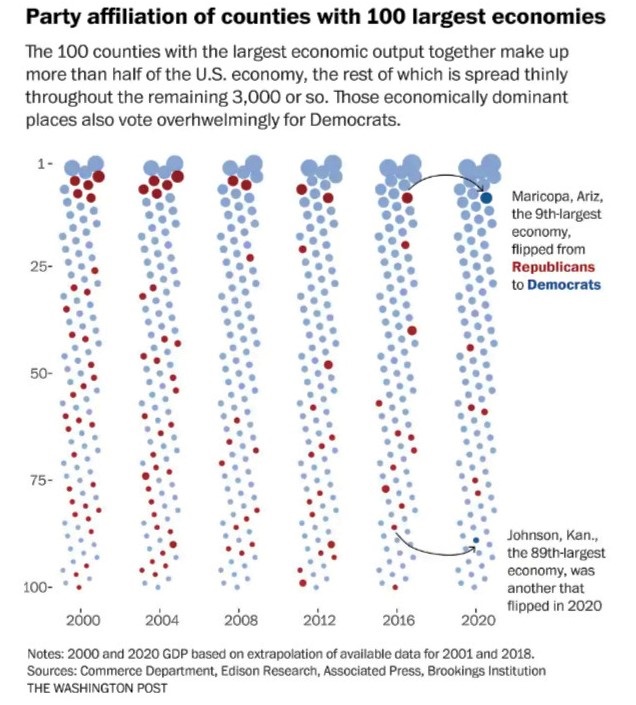Are you better off than you were four years ago?
That question has been at the heart of presidential campaigns since President Ronald Reagan first asked it in 1980.
The general thinking has been that voters who are doing well would vote to reelect a sitting president.
That’s not what happened in 2020.
This time around, those who were better off voted for a change in the White House.
The Washington Post: The parts of America that have seen strong job, population and economic growth in the past four years voted for Joe Biden, economic researchers found.
In contrast, President Trump garnered his highest vote shares in counties that had some of the most sluggish job, population and economic growth during his term.
Trump fared well among voters who said the economy was their top concern, and he even won votes in places that didn’t fare particularly well under his presidency.
This is perhaps a continuation of the 2016 election, when Trump won a huge share of places that had struggled under President Barack Obama.
Democrats tended to view the 2020 election more as a referendum on Trump, especially his response to the pandemic.
These trends help explain why Biden was able to flip the counties that contain Phoenix, Fort Worth and Jacksonville, Fla., all of which are growing and prosperous urban hubs.
And it helps explain why Trump did better than expected in Osceola County and Miami-Dade counties, the two Florida counties with some of the state’s highest unemployment rates.
“Counties where voters feel better off today than four years ago swung toward Biden,” said James Chung, co-founder of StratoDem Analytics, which studies local economic trends. “Counties that declined over the past four years were more likely to shift even more to Trump.”
To be sure, Chung found that — as exit polls have shown — education and race most strongly explained voting patterns, but they were followed closely by a county’s economic performance.
The economy often decides elections, but the surprise in this case was that good economic performance didn’t appear to favor the incumbent.
What occurred in 2020 appears to be part of a larger shift in U.S. politics and economics that has been in motion since the turn of the century.
In almost every election since 2000, Democrats increased their share of votes in urban areas that are densely populated and prosperous, while Republicans have increasingly become the dominant party for voters in smaller cities and rural areas.
The transformation has been swift — and stark.
In the 2000 election, Republican George W. Bush won 2,417 counties that drove 45 percent of the U.S. economy, while Democrat Al Gore won 666 counties that made up to 55 percent of the economy, a fairly even split of the economic map.
In 2020, Biden won 477 counties that account for 70 percent of the U.S. economy, while Trump won 2,497 counties amounting to just shy of 30 percent of the economy, according to an analysis by Mark Muro, senior fellow at the Metropolitan Policy Program at the Brookings Institution, and his team.
For Democrats, it was a notable increase from 2016, when Hillary Clinton won counties amounting to 64 percent of the U.S. economy.
The United States is transforming into a knowledge and digital economy, and the political map appears to be shifting with it.
Some call it the urban versus rural divide, but it is also a digital versus blue-collar split.
Increasingly, blue America is diverse, college-educated and heavily invested in professional and tech businesses.
In contrast, red America is more White, less likely to have gone to college and reliant on blue-collar sectors like manufacturing, construction and energy.
“It’s a fundamentally different economic geography than we saw 30 years ago, and our politics seem to be following pretty closely,” said John Lettieri, president of the Economic Innovation Group. “Democrats are consistently and increasingly capturing the most economically productive and vibrant areas of the country.”
Some warn this political divide could heighten the gridlock in Congress.
If the parties are looking out for such different types of industries and workers, they are unlikely to agree on where to invest money and what policies to prioritize.
This is “not a scenario for economic consensus,” Muro warns.
Muro notes that Biden flipped half of the 10 most “economically significant” counties that Trump won in 2016, including Maricopa County, Ariz. (which includes Phoenix), Tarrant County, Tex. (which includes Fort Worth), Duval County, Fla. (which includes Jacksonville), Morris County, N.J. (a New York City suburb) and Pinellas County, Fla. (which includes St. Petersburg).
A Washington Post analysis of Labor Department data found counties that suffered economically under Obama’s second term flocked to the Trump in 2016, while prosperous counties moved toward Obama’s Democrat successor, Hillary Clinton.
Contrast that with 2020, when the gaps were smaller, but Joe Biden saw the biggest shift in his favor in counties that saw the fastest job growth in the four years of the Trump presidency.
Meanwhile, the largest shift to Trump in 2020 came from counties that saw the least job growth over his term.
In an analysis for The Post, StratoDem Analytics found that three variables best explained voting shifts form 2016 to 2020: educational attainment, race and ethnicity, and county-level economic performance.
Rapidly growing counties around Austin and Dallas turned more blue, primarily because they attracted higher educated workers who are more likely to vote Democratic.
An analysis from the Economic Innovation Group came to a similar conclusion, finding that counties won by Biden have stronger recent growth than counties won by Trump.
The EIG team focused on employment growth, wage growth and growth in the number of businesses in a county from 2018 to the first quarter of 2020 — just before the pandemic caused a devastating downturn.
“Democrats need to figure out what their positive and inclusive vision is that speaks to rural America,” said Kenan Fikri, research director at EIG. “Democrats really didn’t make inroads into rural America this time around.”

